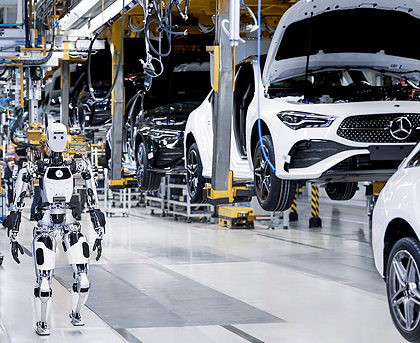- Home » News » World News
Mercedes and BMW explore using humanoid robots

Mercedes-Benz and BMW have announced plans to start testing humanoid robots for possible deployment in their production plants. Mercedes-Benz is exploring using humanoid robots supplied by the US manufacturer Apptronik to carry parts to production lines for workers to assemble, while simultaneously inspecting the components. And BMW is planning to use humanoid robots from the Californian developer Figure AI to perform unspecified tasks at a plant in the US.
These are two a series of developments in recent months that suggest that humanoid robots are starting to migrate from laboratories and YouTube videos to real-world applications in factories in warehouses. In one sign of the rapid pace of developments in this area, researchers at the Goldman Sachs are predicting that the global market for humanoids could be worth $38bn by 2035 – six times larger than they were forecasting a year ago – with 1.4 million of the machines being shipped annually by then.
They are basing their dramatically revised predictions on a combination of plummeting costs, soaring investment in the sector, and the enhanced capabilities that AI is bringing to bipedal robots. The researchers suggest that humanoid robots could achieve two-year paybacks as soon as 2025-2026.
Another powerful indicator is the recent announcement by the chip-maker Nvidia of a series of software and hardware developments aimed at accelerating the development of humanoid robots. The company’s founder and CEO, Jensen Huang, last week described the development of models for humanoid robots as being “one of the most exciting problems to solve in AI today”.
Then there is the news that Figure AI, founded in 2022, has raised $675m of backing from investors including Amazon boss, Jeff Bezos, Nvidia, Microsoft and OpenAI. The company, which is currently valued at $2.6bn, will use the money to accelerate the development of its AI-powered humanoid robot, Figure 01, which is aimed at commercial applications. A recent video (above) showed it interacting using normal spoken English.

In China, a government report last year identified humanoid robots as being a critical technology with a potential for disrupting industry. It called for the establishment of industry clusters specialising in humanoids by 2025, with stable industry chains to integrate humanoid robots into the Chinese economy by 2027. It estimated that China’s humanoid robot market could be worth 870 billion yuan (£96bn) by 2030.
In other developments:
• Tesla is developing its own humanoid robot, called Optimus, which can sort objects autonomously and self-calibrate its arms and legs. A recent recruitment drive suggests that Tesla may be preparing to test the robots in its factories.
• The Chinese car-maker Nio is already testing humanoid robots from UBTech Robotics on an assembly line at one of its factories. The 77kg Walker X robots, which have 41 servo joints, use real-time image-capturing capabilities to perform quality inspections.
• Another Chinese car manufacturer, Xpeng Motors, is developing its own humanoid robots which it plans to introduce to its factories later this year. One goal is for the company’s PX5 robot to be able to walk 10km while carrying a load.
• Boston Robotics has released a video showing its Atlas humanoid robot picking and placing automotive struts. The company is now owned by the Korean car-maker Hyundai, so the robots could find their way into its production plants.
• Oregon-based Agility Robotics, which is developing humanoid robots for warehouse applications, is involved in trials with Amazon and the world’s largest contract logistics provider, GXO logistics. Amazon is testing Agility’s Digit robot at its robotics R&D facility for tasks such as tote recycling – picking and moving empty totes. GXO is testing the 16kg-capacity robots for roles such as moving totes from AMRs (autonomous mobile robots) to conveyors.
• One Chinese humanoid developer, Leju Robot, reckons that the cost of its machines could fall from 600,000 yuan (£63,000) at present to 150,000 yuan (£16,580) by the end of 2025.
In their report, the Goldman Sachs researchers identify and compare nine humanoid robots being developed by companies and organisations outside China – and a further ten in China alone.





